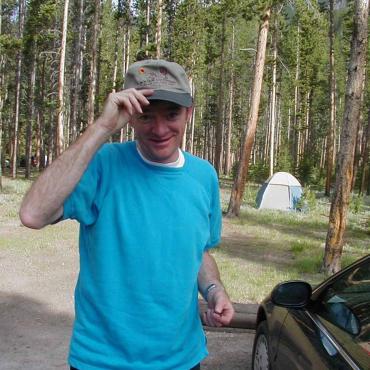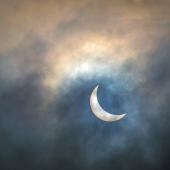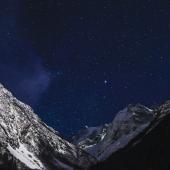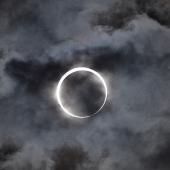The Celestial Ski Course
Winter's bracing air and muffling blanket of snow may send the grizzly into its seasonal coma, but for outdoors lovers, it simply means a change of gear. It's the same for the sky, which this season trots out a set of starry accents to rival the brightly-garbed ski bums and bunnies inhabiting every groomed slope or trail. Follow the celestial signposts, and you'll soon be schussing about the winter sky like a pro.
Winter's brightest stars are arrayed like flags marking a great oval ski course in the heavens. Look for the starting gate in the constellation of Orion the hunter, easily distinguished by his belt of three stars inside a bright rectangle. Orion rises at nightfall in December and stands due south by midnight, reaching this vantage point by 10 p.m. in January and 8 p.m. in February. The bright orange star in his right shoulder, named Betelgeuse, is actually inside the ski oval. Slide across the belt to his left kneecap, and you'll find blue-white Rigel, a supergiant star nearly 800 light years distant that makes a good starting point for the course.
Now trace up and right, past Aldebaran, the ruddy eye of Taurus the bull, to the bull's shoulder: the star cluster called the Pleiades or "Seven Sisters" and the next course marker. A good eye can make out six or seven stars twinkling together; binoculars reveal many more of the 300-odd stars in this clan about 400 light years away.
Circling up and left brings us to Capella, nearly overhead at 10 p.m. in mid-January. The so-called Goat Star is actually a pair of giant yellow suns orbiting each other some 42 light years from Earth, and helps to make the pentagon of Auriga the charioteer.
Now swing down and left to find two bright stars marking the heads of the Gemini brothers, the twins of Greek mythology. Telescopes reveal a multiple personality for Castor, showing it as a pair of white stars, each of which is also a double star. It shines 52 light years away; the pale orange giant Pollux shines a little closer at 34 light years.
We're in the home stretch now. Trace downward for Procyon, a yellow-white sun in Canis Minor, the little dog, circled by a white dwarf star and located just 11 light years away. Continue down and right and you can't miss brilliant white Sirius, the brightest star in the sky and a mere 8.7 light years away, also possessing a white dwarf companion and decorating the neck of Canis Major, the great dog. Swing back up to Rigel, and your journey is complete.
And if you’re wondering, incidentally, who the bright spectator is sitting inside the course this winter as if it were at the Kentucky Derby, that’s the planet Saturn, stationed near the lower horn tip of Taurus.
We're hardly the first to find this race course in the sky, however. The Lakota, or Sioux, called this starry oval the Sacred Hoop, encircling a celestial representation of their sacred Black Hills. Both they and the Cheyenne also called it the Race Track, in reference to an early legend of great import to humans.
One variant of this story relates that in ages past, the buffalo and the human "two-leggeds" were at odds about who should hold dominion in the world—and who should eat whom. (It's said that the hair on the chins of buffalo is the hair of people they once ate—suggesting who had the early edge.) The rivals decided they would have a great race around the Black Hills to decide the question, with the buffalo and other four-leggeds on one side, and humans and birds (also two-legged) on the other.
The race began, and for several days and several laps, the racers thundered around the Black Hills, flecks of blood from their noses and mouths staining the red clay valley that surrounds the hills today. As the race neared its end, a young cow buffalo was well in the lead and things looked bad for humans. But at the last moment, clever Magpie, who had been riding unnoticed on Buffalo's shoulder, leaped into the air and flapped across the finish line just ahead of Buffalo, winning by a beak and carrying the day for the two-leggeds. Thereafter, humans held power over the world and its inhabitants, and turned the tables on the buffalo but respected the magpie and never hunted it.
It's said that the Milky Way, which glimmers faintly across the Race Track, is a lingering cloud of dust raised in the great race. Today we might fancy it as a spray of powder from a well-cut turn down the slopes. Whatever you imagine up there, take time this winter to plant your poles and gaze starward, for adventure lies there, too, in the sparkling scenery of the sky.
The Taylor Planetarium offers guided tours of the universe daily at the Museum of the Rockies, 600 West Kagy Boulevard, Bozeman, MT, 59717, 406-994-2251.












